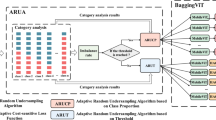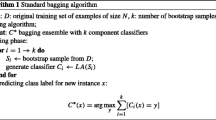Abstract
Existing approaches for handling imbalanced problem are based on the discriminant approaches, while only little attention is dedicated to mining the probability information provided by generative approaches. Moreover, the multi-view learning trains classifier through combining different representations of data for improving the performance of classifier in imbalanced classification. In this paper, a learning framework consisting of fisher kernel and Bi-Bagging is proposed for imbalanced problem. The Fisher kernel is employed to integrate the probability information into the pristine feature of data. Thus, the generated fisher vector contain better discriminatory information. However, the generated fisher vector may lead to high-dimension overfitting. So the dataset represented by the fisher vector is then processed by Bi-Bagging to generate multi-view data and balanced training subsets, which not only reduces the high dimension of generated fisher vector but also promotes the accuracy of minority instances. In one word, the combination of fisher kernel and Bi-Bagging makes use of the probability information in the pristine feature and generates balanced multi-view training subsets with adequate dimension. Therefore, the proposed learning framework is independent of specific models, and the base classifier of the learning framework can be replaced by different linear classifier. Two experimental strategies are implemented to validate the effectiveness of the proposed learning framework for imbalanced datasets on 30 KEEL datasets.



Similar content being viewed by others
References
Akaho S (2006) A kernel method for canonical correlation analysis. arXiv:cs/0609071
Alcalá-Fdez J, Fernández A, Luengo J, Derrac J, García S, Sánchez L, Herrera F (2011) Keel data-mining software tool: data set repository, integration of algorithms and experimental analysis framework. J Multiple-Valued Logic Soft Comput 17:255–287
Bach F, Lanckriet GR, Jordan MI (2004) Multiple kernel learning, conic duality, and the SMO algorithm. In: International conference on machine learning. ACM, pp 6–13
Bishop CM (2007) Pattern recognition and machine learning. Springer
Bryll R, Gutierrez-Osuna R, Quek F (2003) Attribute bagging: improving accuracy of classifier ensembles by using random feature subsets. Pattern Recogn 36(6):1291–1302
Bunkhumpornpat C, Sinapiromsaran K, Lursinsap C (2009) Safe-level-smote: safe-level-synthetic minority over-sampling technique for handling the class imbalanced problem. In: Pacific-Asia conference on advances in knowledge discovery and data mining, pp 475–482
Chaudhuri K, Kakade SM, Livescu K, Sridharan K (2009) Multi-view clustering via canonical correlation analysis. In: International conference on machine learning, pp 129–136
Chawla NV, Bowyer KW, Hall LO, Kegelmeyer WP (2002) Smote: synthetic minority over-sampling technique. J Artif Intell Res 16:321–357
Chen T, Guestrin C (2016) Xgboost; a scalable tree boosting system. In: Proceedings of the 22Nd ACM SIGKDD international conference on knowledge discovery and data mining, KDD ’16. ACM, New York, pp 785–794
Cortes C, Vapnik V (1995) Support vector machine. Mach Learn 20(3):273–297
Fan W, Stolfo SJ, Zhang J, Chan PK (1999) Adacost: misclassification cost-sensitive boosting. In: International conference on machine learning, vol 99, pp 97–105
Fumera G, Roli F (2002) Support vector machines with embedded reject option. Pattern Recogn Support Vector Mach, 68–82
Galar M, Fernandez A, Barrenechea E, Bustince H, Herrera F (2012) A review on ensembles for the class imbalance problem: bagging-, boosting-, and hybrid-based approaches. IEEE Trans Syst Man Cybern Part C (Appl Rev) 42(4):463–484
Guo H, Li Y, Li Y, Liu X, Li J (2016) Bpso-adaboost-knn ensemble learning algorithm for multi-class imbalanced data classification. Eng Appl Artif Intel 49:176–193
Han H, Wang W, Mao BH (2005) Borderline-smote: a new over-sampling method in imbalanced data sets learning. In: Advances in intelligent computing, vol 3644. Springer, pp 878–887
He HB, Garcia EA (2009) Learning from imbalanced data. IEEE Trans Knowl Data Eng 21(9):1263–1284
Ho TK (1995) Random decision forests. In: International conference on document analysis and recognition, vol 1. IEEE, pp 278–282
Hosmer DW Jr, Lemeshow S, Sturdivant RX (1991) Applied logistic regression. Stat Med 10(7):1162–1163
Hotelling H (1935) Relations between two sets of variants. Biometrika 28(3-4):312–377
Jaakkola TS, Haussler D (1998) Exploiting generative models in discriminative classifiers. Adv Neural Inf Process Syst 11(11):487–493
Jo T, Japkowicz N (2004) Class imbalances versus small disjuncts. ACM Sigkdd Explor Newslett 6(1):40–49
Sham MK, Dean PF (2007) Multi-view regression via canonical correlation analysis. Lect Notes Comput Sci 4539:82–96
Kwok T (1999) Moderating the outputs of support vector machine classifiers. IEEE Trans Neural Netw 10 (5):1018–1031
Lanckriet GRG, Cristianini N, Bartlett P, Ghaoui LE, Jordan MI (2004) Learning the kernel matrix with semidefinite programming. J Mach Learn Res 5(Jan):27–72
Leski J (2003) Ho–kashyap classifier with generalization control. Pattern Recogn Lett 24(14):2281–2290
Li Q, Li G, Niu WJ, Cao Y, Chang L, Tan J, Guo L (2016) Boosting imbalanced data learning with wiener process oversampling. Front Comput Sci, 1–16
Liu XY, Wu JX, Zhou ZH (2009) Exploratory undersampling for class-imbalance learning. IEEE Trans Syst Man Cybern Part B (Cybern) 39(2):539–550
Maloof MA (2003) Learning when data sets are imbalanced and when costs are unequal and unknown. In: International conference on machine learning workshop learning from imbalanced data sets II
Masnadi-Shirazi H, Vasconcelos N, Iranmehr A (2012) Cost-sensitive support vector machines. arXiv:1212.0975
Muslea I, Minton S, Knoblock CA (2002) Adaptive view validation: a first step towards automatic view detection. In: International conference on machine learning, pp 443–450
Muslea I, Minton S, Knoblock CA (2003) Active learning with strong and weak views: a case study on wrapper induction. In: International joint conference on artificial intelligence, vol 3, pp 415–420
Muslea IA (2011) Active learning with multiple views. J Artif Intell Res 27(1):203–233
Nigam K, Ghani R (2000) Analyzing the effectiveness and applicability of co-training. In: International conference on information and knowledge management, pp 86–93
Platt J (1998) Sequential minimal optimization: a fast algorithm for training support vector machines. In: Advances in kernel methods-support vector learning, pp 212–223
Rakotomamonjy A, Bach F, Canu S, Grandvalet Y (2007) More efficiency in multiple kernel learning. In: International conference on machine learning, pp 775–782
Rakotomamonjy A, Bach F, Canu S, Grandvalet Y (2008) Simplemkl. J Mach Learn Res 9(3):2491–2521
Seiffert C, Khoshgoftaar TM, Van HJ, Napolitano A (2010) Rusboost: a hybrid approach to alleviating class imbalance. IEEE Trans Syst Man Cybern-Part A: Syst Humans 40 (1):185– 197
Sonnenburg S (2005) A general and efficient multiple kernel learning algorithm. Adv Neural Inf Process Syst 18:1273–1280
Subrahmanya N, Shin YC (2010) Sparse multiple kernel learning for signal processing applications. IEEE Trans Pattern Anal Mach Intell 32(5):788–798
Sun B, Chen HY, Wang J, Xie H (2018) Evolutionary under-sampling based bagging ensemble method for imbalanced data classification. Front Comput Sci 12(2):331–350
Sun Y, Wong AKC, Kamel MS (2009) Classification of imbalanced data: a review. Int J Pattern Recogn Artif Intell 23(4):687–719
Szafranski M, Grandvalet Y, Rakotomamonjy A (2010) Composite kernel learning. Mach Learn 79 (1–2):73–103
Wang Q, Luo Z, Huang J, Feng Y, Liu Z (2017) A novel ensemble method for imbalanced data learning: bagging of extrapolation-smote svm. Comput Intell Neurosci 2017:11
Wang W, Zhou ZH (2010) A new analysis of co-training. In: International conference on international conference on machine learning, pp 1135–1142
Xu C, Tao D, Xu C (2013) A survey on multi-view learning. arXiv:1304.5634
Xu Z, Jin R, Yang H, King I, Lyu MR (2010) Simple and efficient multiple kernel learning by group lasso. In: International conference on machine learning, pp 1175–1182
Yu S, Krishnapuram B, Rosales R, Rao RB (2011) Bayesian co-training. J Mach Learn Res 12 (3):2649–2680
Zhu YJ, Wang Z, Gao DQ (2015) Gravitational fixed radius nearest neighbor for imbalanced problem. Knowl-Based Syst 90:224–238
Acknowledgments
This work is supported by Natural Science Foundation of China under Grant No. 61672227, “Shuguang Program” supported by Shanghai Education Development Foundation and Shanghai Municipal Education Commission, and National Science Foundation of China for Distinguished Young Scholars under Grant 61725301.
Author information
Authors and Affiliations
Corresponding authors
Additional information
Publisher’s note
Springer Nature remains neutral with regard to jurisdictional claims in published maps and institutional affiliations.
Rights and permissions
About this article
Cite this article
Wang, Z., Zhu, Y., Chen, Z. et al. Multi-view learning with fisher kernel and bi-bagging for imbalanced problem. Appl Intell 49, 3109–3122 (2019). https://doi.org/10.1007/s10489-019-01428-1
Published:
Issue Date:
DOI: https://doi.org/10.1007/s10489-019-01428-1




